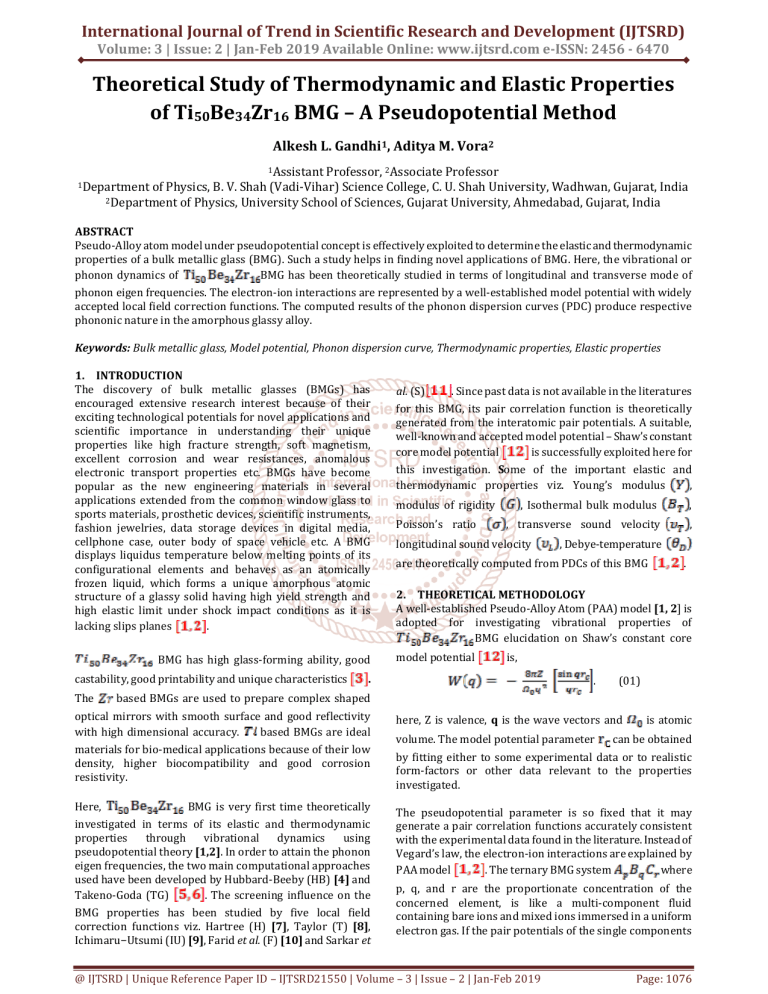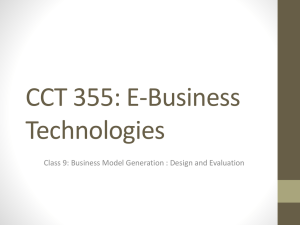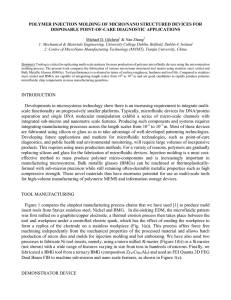
International Journal of Trend in Scientific Research and Development (IJTSRD)
Volume: 3 | Issue: 2 | Jan-Feb 2019 Available Online: www.ijtsrd.com e-ISSN: 2456 - 6470
Theoretical Study of Thermodynamic and Elastic Properties
of Ti50Be34Zr16 BMG – A Pseudopotential Method
Alkesh L. Gandhi1, Aditya M. Vora2
Professor, 2Associate Professor
of Physics, B. V. Shah (Vadi-Vihar) Science College, C. U. Shah University, Wadhwan, Gujarat, India
2Department of Physics, University School of Sciences, Gujarat University, Ahmedabad, Gujarat, India
1Department
1Assistant
ABSTRACT
Pseudo-Alloy atom model under pseudopotential concept is effectively exploited to determine the elastic and thermodynamic
properties of a bulk metallic glass (BMG). Such a study helps in finding novel applications of BMG. Here, the vibrational or
phonon dynamics of
BMG has been theoretically studied in terms of longitudinal and transverse mode of
phonon eigen frequencies. The electron-ion interactions are represented by a well-established model potential with widely
accepted local field correction functions. The computed results of the phonon dispersion curves (PDC) produce respective
phononic nature in the amorphous glassy alloy.
Keywords: Bulk metallic glass, Model potential, Phonon dispersion curve, Thermodynamic properties, Elastic properties
1. INTRODUCTION
The discovery of bulk metallic glasses (BMGs) has
encouraged extensive research interest because of their
exciting technological potentials for novel applications and
scientific importance in understanding their unique
properties like high fracture strength, soft magnetism,
excellent corrosion and wear resistances, anomalous
electronic transport properties etc. BMGs have become
popular as the new engineering materials in several
applications extended from the common window glass to
sports materials, prosthetic devices, scientific instruments,
fashion jewelries, data storage devices in digital media,
cellphone case, outer body of space vehicle etc. A BMG
displays liquidus temperature below melting points of its
configurational elements and behaves as an atomically
frozen liquid, which forms a unique amorphous atomic
structure of a glassy solid having high yield strength and
high elastic limit under shock impact conditions as it is
lacking slips planes
.
BMG has high glass-forming ability, good
castability, good printability and unique characteristics
The
. Since past data is not available in the literatures
for this BMG, its pair correlation function is theoretically
generated from the interatomic pair potentials. A suitable,
well-known and accepted model potential – Shaw’s constant
core model potential
is successfully exploited here for
this investigation. Some of the important elastic and
thermodynamic properties viz. Young’s modulus
,
modulus of rigidity
Poisson’s ratio
, Isothermal bulk modulus
,
, transverse sound velocity
longitudinal sound velocity
,
, Debye-temperature
are theoretically computed from PDCs of this BMG
.
2. THEORETICAL METHODOLOGY
A well-established Pseudo-Alloy Atom (PAA) model [1, 2] is
adopted for investigating vibrational properties of
BMG elucidation on Shaw’s constant core
model potential
is,
.
.
(01)
based BMGs are used to prepare complex shaped
optical mirrors with smooth surface and good reflectivity
with high dimensional accuracy.
based BMGs are ideal
materials for bio-medical applications because of their low
density, higher biocompatibility and good corrosion
resistivity.
Here,
al. (S)
BMG is very first time theoretically
investigated in terms of its elastic and thermodynamic
properties
through
vibrational
dynamics
using
pseudopotential theory [1,2]. In order to attain the phonon
eigen frequencies, the two main computational approaches
used have been developed by Hubbard-Beeby (HB) [4] and
Takeno-Goda (TG)
. The screening influence on the
BMG properties has been studied by five local field
correction functions viz. Hartree (H) [7], Taylor (T) [8],
Ichimaru−Utsumi (IU) [9], Farid et al. (F) [10] and Sarkar et
here, Z is valence, q is the wave vectors and
volume. The model potential parameter
is atomic
can be obtained
by fitting either to some experimental data or to realistic
form-factors or other data relevant to the properties
investigated.
The pseudopotential parameter is so fixed that it may
generate a pair correlation functions accurately consistent
with the experimental data found in the literature. Instead of
Vegard’s law, the electron-ion interactions are explained by
PAA model
. The ternary BMG system
where
p, q, and r are the proportionate concentration of the
concerned element, is like a multi-component fluid
containing bare ions and mixed ions immersed in a uniform
electron gas. If the pair potentials of the single components
@ IJTSRD | Unique Reference Paper ID – IJTSRD21550 | Volume – 3 | Issue – 2 | Jan-Feb 2019
Page: 1076
International Journal of Trend in Scientific Research and Development (IJTSRD) @ www.ijtsrd.com eISSN: 2456-6470
are known, the mean effective density dependent
interatomic pair potential V(r) can be derived successfully
. Here, the fundamental component pair potential
is given by,
arises from repulsion of the d-electron muffin-
tin orbitals on different sites due to their non-orthogonality.
Wills and Harrison
studied the effects of the s-band
and d-band.
(02)
.
The contribution from the s-electron to the pair potential
is then,
(03)
Where,
Here,
Where,
(05)
is the local field correction function,
and
are mass and charge of an electron respectively For BMG, the
model potential parameter
[1, 2, 15] is given below.
(06)
is the core radius. The number of s-valance
electron
is obtained by integrating the partial S-
density of states, which result from the self-consistent band
structure computation for the entire
series and
series. The number of d-electrons contributing to the
pair-potential is
. The d-state radii
and the nearest
neighbor coordinate number N are given by
,
Where,
is the Wigner Seitz radius of the BMG.
The input parameters of s-electron valance (ZS), d-electron
valance (Zd), d-band radius (Rd), Wigner-Seitz radius (RS),
Volume (
), Coordination. No. (N), Mass (M) and Core
radius (Rc) are used for computation and tabulated in table:
1.
(04)
Table 1: Input parameters and Constants useful in the computational work.
M
3.32
The parameters
,
,
1.50
1.65
1.45
1.9465
and N are determined from
band structure data of pure metallic component which are
already found in the literature [1, 2, 15] and obtained by the
following expressions.
(07)
102.56
7.92
of rigidity
67.54
0.6654
, Poisson’s ratio
and the Debye temperature
are derived by the formulae [1, 2] given below.
(13)
(14)
(08)
(09)
N=
,
,
(10)
is valency. The PCF
(15)
is as
important as the interatomic pair potential V(r) in studying a
BMG [1, 2, 16].
(11)
Where,
is Room temperature and
(16)
, the Boltzmann’s
(17)
constant.
The mathematical notations and theoretical discussions are
found from the respective papers of HB- and TG- approaches
. In the long wavelength limit of the
phonon frequency spectrum, the longitudinal and transverse
frequencies are proportional to the wave vectors.
and
. (12)
The longitudinal and transverse sound velocities (
and
respectively) are computed from the long-wavelength
limits of the PDCs as given in the literatures [1, 2, 4-6].
Young’s modulus , Isothermal bulk modulus
, Modulus
Here,
is the Debye frequency,
is isotropic number
density.
3. RESULTS AND DISCUSSION:
Figures 1 and 2 show the PDCs of for longitudinal and
transverse modes of phonon eigen frequencies (
and
) versus wave vector
computed with HB−
and TG− approaches respectively with the ive local ield
screening functions Viz. H, T, IU, F and S. The obtained
phonon dynamical or vibrational properties for this BMG can
be compared with the other such and experimentally
generated data whenever available.
@ IJTSRD | Unique Reference Paper ID – IJTSRD21550 | Volume – 3 | Issue – 2 | Jan-Feb 2019
Page: 1077
International Journal of Trend in Scientific Research and Development (IJTSRD) @ www.ijtsrd.com eISSN: 2456-6470
The inclusion of exchange and correlation effect increases
the phonon eigen frequencies for both longitudinal and
transverse modes. For the HB-approach, the plot of T-, S- and
F- screening functions are lying between those due to H- and
IU-screening functions for both branches. In TG-approach,
the plots of H-, T- and F-are lying between those of S- and IUfunctions for both branches.
The first minimum for the longitudinal frequency
the HB-approach, is found around at
and
for H- T-, IU- F- and S- functions respectively.
Typically, the dispersion relations express a minimum near
, the wave-vector where the static structure factor
of the BMG has its first maximum. The first maximum for the
longitudinal frequency
in the HB-approach is
found around at
in
approach, it is found around at
for H-
function,
for H-
for T- IU and F- functions and
for the rest of the functions; in the TG-
approach, it is found around
for all functions; in the TG-
for S-function.
and
In the HB approach, the first minimum transverse frequencies
for all functions are found around
while in TG approach, it is found at
respectively for the H-, T-, IU-, F- and S- functions.
For the transverse branch
and
the first maximum is found around at
for F-
;
for the rest of
local field correction functions in HB- approach, In the TG
approach, it is found around at
and
for H-, T, IU-, F- and S-functions respectively.
@ IJTSRD | Unique Reference Paper ID – IJTSRD21550 | Volume – 3 | Issue – 2 | Jan-Feb 2019
Page: 1078
International Journal of Trend in Scientific Research and Development (IJTSRD) @ www.ijtsrd.com eISSN: 2456-6470
Figure : PDCs of longitudinal and transverse Phonon frequencies for
The first crossover position of
and
functions. The first crossover position of
BMG using HB approach.
in the HB-approach is observed at
and
for all local field correction
in the TG-approaches is seen at
and
for
H, T-, IU- and F- and S- functions respectively
These both PDCs collectively disclose that the longitudinal mode oscillations are more prominent than that of the transverse
one. The instability of the transverse mode oscillations is due to anharmonicity of the atomic vibration in the BMG system. The
collective excitations at larger momentum transfer is because of the prominence of longitudinal mode vibrations only.
Table2: Elastic and Thermodynamic properties of
App.
HB-approach
TG-approach
BMG.
SCR
H
T
IU
F
S
H
T
IU
F
S
K
σ
2.62
3.59
3.79
3.78
2.85
2.67
2.47
2.69
2.69
2.07
1.51
2.07
2.19
2.18
1.65
0.99
1.01
1.09
1.09
0.82
1.69
3.18
3.54
3.52
2.00
2.59
2.10
2.52
2.51
2.57
1.02
1.91
2.12
2.11
1.20
0.43
0.45
0.52
0.53
0.51
0.25
0.25
0.25
0.25
0.25
0.42
0.40
0.40
0.40
0.41
@ IJTSRD | Unique Reference Paper ID – IJTSRD21550 | Volume – 3 | Issue – 2 | Jan-Feb 2019
2.54
4.77
5.30
5.29
3.00
1.23
1.27
1.47
1.48
1.44
200.46
274.71
289.60
289.08
217.96
133.76
136.66
146.89
147.45
126.67
Page: 1079
International Journal of Trend in Scientific Research and Development (IJTSRD) @ www.ijtsrd.com eISSN: 2456-6470
4. CONCLUSION:
It is concluded that the phonon dynamics of
BMG can be estimated by the PDC generated
form HB- and TG- approaches with five local field correction
functions, due to H-, T, IU-, F- and S-, with the successful
application of the Shaw’s model potential, produce all broad
characteristics of the dispersion curves and predict for the
various useful thermodynamic and elastic properties under
investigation. . The computed PDCs show extensive features
of broad range collective excitations in
BMG.
The dielectric function is significant in the computation of
the screening potential due to electron gas and the local filed
correction functions. The relative effects of exchange and
correlation in the selected properties, examined by different
local field correction functions, show variations according to
the vibrational properties. The thermodynamic properties
obtained due to BS-approach are higher than those due to
HB or TG-approaches. The complete picture tells the
importance of local field correction function as well as the
approaches in analysing the properties of the BMG. Since the
experimentally or theoretically observed data of most of this
BMG are not available in the literature, it is difficult to make
any special remarks. However, this investigation proves to
be very useful to offer vital information concerning a
particular BMG system.
References:
[1] A. M. Vora, Vibrational Dynamics of Binary Metallic
Glasses, Lap Lambert Academic Publishing, Germany
(2012).
[2] A. M. Vora, Vibrational Dynamics of Bulk Metallic
Glasses Studied By Pseudopotential Theory,
Computational Materials, Ed. Wilhelm U. Oster, Nova
Science Publishers, Inc., New York (2009), pp.119-176.
[3] A. Inou, X.M. Wang and W. Zhang, Rev. Adv. Mater. Sc.,
Vol. 18, (2008), pp. 1-9.
[5] S. Takeno; M. Goda, Prog. Thero. Phys., (1971), Vol. 45,
pp. 331-352.
[6] S. Takeno; M. Goda, Prog. Thero. Phys., (1972), Vol. 47,
pp. 790-806.
[7] W. A. Harrison, Elementary Electronic Structure,
(1999), World Scientific, Singapore.
[8] R. Taylor, J. Phys. F: Met. Phys., (1978), Vol. 8, pp. 16991702.
[9] S. Ichimaru; K. Utsumi, Phys. Rev. B., (1981), Vol. 24, pp
7385-7388.
[10] B. Farid; V. Heine; G. Engel, I. Robertson, J. Phys. Rev. B.
(1993), Vol. 48, pp.11602-11621.
[11] A. Sarkar; D.S. Sen; S. Haldar; D.Roy, Mod. Phys. Lett., B.
(1998), Vol. 12, pp. 639-648.
[12] R.W.Shaw, Phy. Rev., (1968), Vol. 174, p. 769.
[13] Gupta A.; Bhandari D.; Jain K. C.; Saxena N. S. Phys. Stat.
Sol. (b). Vol. 95, (1996), pp. 367-374.
[14] W. A. Harrison, Pseudopotentials in the Theory of
Metals, (1966), W. A. Benjamin, Inc., New York.
[15] J. M. Wills; W.A. Harrison, Phys. Rev B., (1983), Vol. 28,
pp. 4363-4373.
[16] E. TFaber, Introduction to the Theory of Liquid Metals;
(1972), Cambridge Uni. Press: London.
[17] V. Heine and D. Weaire, Solid State Physics 24, Eds. H.
Ehrenreich, F. Seitz and D. Turnbull, Academic Press,
New York (1970) p.249.
[18] L. I. Yastrebov and A. K. Katsnelson, Foundations of
One-Electron Theory of Solids, (1987), Mir
Publications, Moscow.
[19] J. M. Ziman, Principal of the theory of the solids, 2nd
edition, (1972), Cambridge Uni. Press, London.
[4] J. Hubbard; J. L. Beeby, J. Phys. C: Solid State Phys,
(1969), Vol. 2, pp. 556-571.
@ IJTSRD | Unique Reference Paper ID – IJTSRD21550 | Volume – 3 | Issue – 2 | Jan-Feb 2019
Page: 1080



